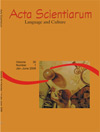<b>Problems of translating two Nigerian novels into German</b> - DOI: 10.4025/actascilangcult.v30i1.4057
Resumo
Apolo y las putas faz parte de uma coleção de cinco contos de Carlos Fuentes, intitulado El naranjo (1993). Vince Valera, um ator de cinema estadunidense, grau B, “o miserável Apolo de celulóide”, de origem irlandesa, toma um avião de Los Angeles a Acapulco. Na primeira noite encontra-se num motel chamado The Fairy Tale. No fim da noite acabou convencendo a dona, “Branca de Neve”, e sete jovens prostitutas para fazerem uma viagem de barco, com o nome significativo de The two Américas. Vince inicia uma orgia com os sete “anões”, resultando em sua “morte por êxtase”, e no dia seguinte, em sua castração. O navio é localizado pela polícia e uma das garotas leva o corpo de Vince a seu vilarejo onde ela o enterra. Discutir-se-ia que o foco está menos sobre a “re-invenção da história” do que sobre a “re-combinação” ou a “re-invenção da literatura”. Apolo y las putas está determinado pelo discurso metaficcional no qual vários fragmentos de uma grande número de sistemas de referência serve como geradores de reflexão poética. O objetivo desse ensaio é mostrar que o conto Apolo y las putas é um construto intertextual lúdico no qual Fuentes se apropria de material pré-existente como repertório de seus motivos, mitemas, citações abertas ou obscuras, procedimentos e técnicas narrativas e até de conceitos da teoria literária contemporânea para executar seu projeto da “re-combinação da literatura”.Downloads
DECLARAÇÃO DE ORIGINALIDADE E DIREITOS AUTORAIS
Declaro que o presente artigo é original, não tendo sido submetido à publicação em qualquer outro periódico nacional ou internacional, quer seja em parte ou em sua totalidade.
Os direitos autorais pertencem exclusivamente aos autores. Os direitos de licenciamento utilizados pelo periódico é a licença Creative Commons Attribution 4.0 (CC BY 4.0): são permitidos o acompartilhamento (cópia e distribuição do material em qualqer meio ou formato) e adaptação (remix, transformação e criação de material a partir do conteúdo assim licenciado para quaisquer fins, inclusive comerciais.
Recomenda-se a leitura desse link para maiores informações sobre o tema: fornecimento de créditos e referências de forma correta, entre outros detalhes cruciais para uso adequado do material licenciado.




















6.png)









